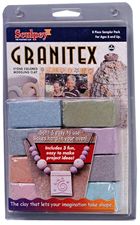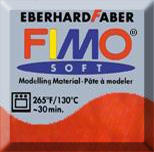Scratch & Bash
:
How-to's
Building with Polymer Clay - Part 5
Oct 24, 2007


By Jeanne DeVoto |
Author
Bio
What is stone clay and how can I use it? Learning about translucent clays too. Stone clay is one of the newest innovations in polymer clay. These clays
produce a variegated, multicolored texture, instead of the continuous tone of standard clay. You can use these clays to produce many new effects, but they require special handling for the best results.
|
What does "stone clay" mean? Stone clay is one of the newest innovations in polymer clay. These clays produce a variegated, multicolored texture, instead of the continuous tone of standard clay. You can use these clays to produce many new effects, but they require special handling for the best results. What stone clays are there? 
Both Eberhard Faber (stone Fimo) and Polyform Products (Granitex) make polymer clays designed to imitate stone. Stone Fimo comes in six colors: lapis lazuli (dark blue), granite (gray), china jade (pale green), rose quartz (pink), jasper (brown), and turquoise (light blue). Granitex comes in eight colors: pink, light blue, dark blue, purple, gray, brown, orange, and green. Granitex is softer and easier to work with than stone Fimo, which has the stiffness characteristic of Fimo. Some of the stone Fimo colors (in particular lapis lazuli and granite) are more realistic, if you are planning to use the clay by itself. All these clays come in the usual approximately-2-oz. packages; there is also a "sample pack" of Granitex containing 1 oz. of each color. How do they get the stone effect in the clay? Stone clays consist of clay in a base color, plus tiny fibers in one or more contrasting colors, mixed through the clay. These fibers provide a granular appearance that (unlike marbled clay) doesn't get blended away as you work the clay. The lapis lazuli and granite colors of stone Fimo also have metallic glitter embedded in the clay, for an even more interesting texture.
How should stone clays be handled? For the most part, these clays are used just like any other polymer clay. You condition, shape, and fire them the same way as regular clay. However, because stone clay has fibers mixed with it, it needs to be handled differently when cutting. When you slice these clays with a knife (or other sharp edge, such as a cookie cutter), the fibers tend to catch on the blade and be dragged down to the bottom of the slice. This creates a dark blotch at the bottom where the fibers have clumped up. (You can try to salvage this situation by gently wiping this blotch with a piece of soft solid-colored clay; it will pick up some of the fibers.) Because of this, you should avoid cutting stone clays with a knife if at all possible. To divide up the clay, pull off pieces with your hands, or cut it with a needle - since the needle doesn't have a sharp edge, it won't catch the fibers in the clay. Can I use the stone clays in canework? Unfortunately, the fibers make it difficult or impossible to use stone clays in canes. This is because when you slice the cane, the embedded fibers catch on the blade and drag through the clay, smearing the cane pattern. This happens regardless of how sharp your blade is; all blades seem to have this problem with the fibers. How can I get a look more like real stone? Some of the clays are better than others at imitating stone. You can marble several colors of clay together to achieve an effect more like the irregular color patterns seen in natural stone. Try these combinations: gray (or granite) with blue (or lapis) and violet green with brown and a touch of orange gray with orange or pink (or rose quartz) translucent with one or two stone colors green and gray, combined with leaf green solid clay The stone clays also take well to wet-sanding and long buffing; this creates a smooth, reflective texture like polished stone. For a rougher, just-quarried look, roll your unfired pieces in salt, fire, then wash the salt off. The salt grains will leave tiny pits and scratches in the clay. What is translucent clay used for? 
Translucent clay can be used for a variety of special effects. You can mix in small amounts of colored clay to produce a watercolor effect. Translucent clay by itself looks something like alabaster. You can lay a thin layer of translucent clay over a strongly-colored pattern to create a milky surface. And translucent clays are often used in combination with colors to produce faux stones like ivory, jade, and amber.
How are translucent clays different from colored clays? Translucent clay is polymer clay with no pigment (coloring element) or opacifier. You can use translucent clays for anything you use colored clays for; conditioning, mixing and marbling, canework, or anything else. However, there are a few overall differences. Translucent clays are often softer and stickier when conditioned than the same brand of colored clay. Also, many translucent clays require a lower firing temperature to avoid darkening; see the instructions on the package. (If you're using colored and translucent clay in the same piece, fire at the lower temperature.) What are the differences between translucent clays? Most clay manufacturers offer one or more translucent clays. Sculpey translucent #510 is one of the most transparent of the clays, very soft, and tends to pick up a yellowish tinge when fired longer than the minimum time. Fimo offers two translucent clays. Fimo art translucent #00, which is only sold in 12-ounce blocks, is preferred for making faux stones because the fired clay develops plaques, tiny imperfections that enhance the clay's resemblance to natural stone. This clay tends to darken at high temperatures. Fimo transparent/opaque #01 is one of the least transparent of the translucent clays, but unlike art translucent, it does not readily change color at normal firing temperatures of 250-275? Fahrenheit and does not plaque as much. How can I enhance the transparency of my pieces? The translucent clays are not truly transparent, but here are a few ways to increase their transparency: If you're mixing colored clay with transparent clay to produce a color-wash effect, don't use too much of the colored clay; the pigment will make the clay less transparent. Try mixing a pea-sized ball of colored clay with a golfball-sized ball of translucent. Wet-sand and buff the piece. Pieces finished this way look more translucent than pieces finished with a gloss glaze. After buffing, heat the piece at 200? Fahrenheit, and then brush a thin coat of Future acrylic floor wax onto the warm piece. This particularly enhances the translucency of tinted clay. These methods produce the translucency you see in semi-precious stones like aventurine or jade - a sense of depth - but not true transparency. Can I make an object that's truly transparent? As of now, there are no truly transparent polymer clays (and given the limitations of polymer chemistry, there may never be such clays). You can obtain a near-transparent effect by putting a very thin layer of translucent clay over an object, firing, then wet-sanding and buffing it, although there will be some cloudiness. You can also use glass marbles or stones as a transparent element of your design along with the clay. Check out the article in the July/August 1996 issue of Jewelry Crafts magazine on using glass marbles with tiny polymer-clay designs to create beads. Why does my transparent clay have little flecks in it? Transparent clays can develop tiny flaws while firing. The effect is called "plaquing". Fimo art translucent #00 in particular tends to plaque. Some artists seek out this effect, because it can be used in faux stones to make the pieces look more like natural stone. You can reduce the plaquing by using a different translucent clay - for example, Fimo transparent/opaque #01 - or by placing your pieces in a cold oven and then turning it on for firing, then letting the pieces cool down in the oven after firing. On the other hand, if you want the plaquing effect, you can enhance it by putting your pieces into a preheated oven and removing them as soon as firing is complete. Wet-sanding and buffing will also make the plaquing more visible. Is polymer clay safe to use?  
Polymer clay is, generally speaking, not dangerous at all for ordinary use. There are a few basic safety rules you should keep in mind to avoid any problems: don't accidentally eat bits of the clay, be careful not to let the plasticizer in the clay get into food, and don't burn or scorch the clay during firing. Can I use my kitchen utensils with both clay and food? This isn't a good idea. It's difficult or impossible to remove all the clay particles from some utensils (such as the pasta machine), and the plasticizer in the clay may remain on or in surfaces, particularly porous ones such as plastic. To be safe, don't use utensils for food again once you've used them with clay. (You may even want to label your clay utensils to make sure no one accidentally uses them in the kitchen.)
Can I use polymer clay to decorate food-serving pieces? Residual plasticizer can remain in the clay after firing, and this plasticizer might leach out into food that touches even the fired clay, so it may not be safe to use polymer clay on surfaces that will be in contact with food. This shouldn't be a problem for pieces that don't touch food directly, such as napkin rings. If you want to use polymer clay for a serving dish, consider sandwiching your clay design between two pieces of glass - that way it can be seen without touching the food on the dish. How do I get this gunk off my hands? The clay is safe to touch, but you shouldn't ingest it, so you need to clean your hands thoroughly after you work with the clay and before you eat or cook. Polymer clay sneers at soap and water. You can keep a rough towel or a package of wet wipes near your workspace, to remove the worst of it when you want to switch between colors of clay. Using a small pumice stone with soap will help remove the clay from your hands; so will some hand creams and facial "scrubs". Another effective cleanup method is to rub a little oil (cooking or mineral oil) onto your hands, then wash it off with ordinary dish soap. (Thanks to Cristy Anspach for this tip.) Are there any dangers from firing the clay? The main thing to remember when firing the clay is not to let your oven temperature get too high. If the clay gets hotter than 300? Fahrenheit, it can burn, and burning PVC gives off toxic fumes. To avoid any chance of burning the clay, get an oven thermometer and calibrate the oven you'll be using. It's common for home ovens to be 25 degrees off the temperature on the dial, and if your oven runs hot you may be firing the clay at too high a temperature. Fire in a well-ventilated room; open your kitchen windows, and if you have a stovetop fan, turn it on during firing. For an extra margin of safety, some clayworkers fire in a toaster oven or portable convection oven which is placed outside, on a deck or patio. Polymer clay normally gives off a slight odor when firing; this is nothing to worry about and not a sign that the clay is burning. Burning clay smells acrid and may cause your eyes or throat to sting. If you do burn a batch of clay, turn off the oven, open windows and turn on fans, and leave the house for an hour or two to give the fumes time to clear. Attention bird-lovers: Birds are reportedly extra-sensitive to fumes, so if you have a bird, it may be safer to put either bird or oven outside while you're firing. Do I need to do anything special when finishing my clay pieces? The rules for safety while sanding or buffing clay are similar to the rules for sanding wood or other materials. If you're dry-sanding (instead of sanding under water) or drilling a clay piece, use a face mask to avoid inhaling the tiny clay particles coming off the sandpaper. You should also use a face mask when working with aluminum-based metallic powders, since these fly everywhere and can cause damage if they're breathed into your lungs. Always, without exception, use eye protection when using any power tool with the clay, whether for drilling, buffing, or sanding. It's very easy for a bead you're buffing to get loose and go flying, possibly into your face. Even the tiny clay particles can get into your eye and cause injury. You can buy plastic safety goggles at any hardware store. Is polymer clay safe for kids to use? Sure, as long as the kids are old enough not to try eating the clay. Children too young to use an oven safely will require supervision during firing. Soft clays such as Sculpey are easier to handle and may be more satisfying for younger kids than the stiffer clays; try making marbled beads or simple canes. Will the clay hurt my furniture? The plasticizer in unfired clay can be harmful to wood finishes, and it eats into some kinds of plastic. If you need to set clay down on a table or a surface other than your work surface, wrap it in waxed paper first to keep it away from the finish. Fired clay is neutral and can be put anywhere. Top of Page
|



